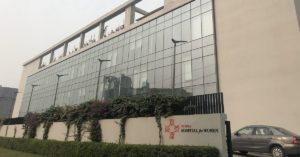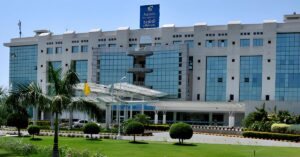Best Doctors in India for Otoplasty
Best Hospitals in India for Otoplasty
- City: Mumbai, India
Hospital Highlights:
- Fortis Hiranandani hospital was established in 2007.
- The hospital is an advanced tertiary care, multi-specialty hospital equipped with 149 beds.
- The hospital is equipped with a super ICU to provide emergency medical care to critically ill patients.
- The hospital is NABH accredited.
- The critical care facility in the hospital is augmented with the state-of-the-art facilities that facilitate speedier diagnosis and efficient monitoring.
- The hospital provides specialty medical services in cardiology, orthopedic science, pediatric science, neurology, diabetic care, urology, nephrology, ENT, obstetrics, gynecology, cosmetic surgery, bariatric surgery, neuro and spine care.
- City: Gurugram, India
Hospital Highlights:
- W Pratiksha Hospital, Gurugram, is one of the best hospitals in the NCR region. It is also a top hospital in India for IVF. Since its inception, the hospital has performed over 5500 successful IVFs. The hospital also specializes in gynecology.
- With over 20 years of experience in providing quality healthcare, the hospital is known as one of the most trusted and valued health providers in India.
- Equipped with world-class medical facilities and advanced technology, the hospital’s doctors and clinicians also have a track record of delivering excellent results. The hospital is also known for focusing on preventive well-being as much as on curative treatment.
- The hospital has earned the trust of its patients, by providing the best available treatments at affordable costs.
- City: Gurugram, India
Hospital Highlights:
- Paras hospital was established in 2006 and is the 250 bedded flagship hospital of Paras Healthcare.
- The is supported by a team of doctors of international and national repute.
- The hospital is NABH accredited and also the first hospital in the region to have a NABL accredited laboratory.
- The hospital provides specialty medical services in around 55 departments including Neurosciences, Joint Replacement, Mother & Child Care, Minimal Invasive Surgery, Gynecology and Obstetrics, Ophthalmology, Dermatology, Endocrinology, Rheumatology, Cosmetic and Plastic surgery.
- The hospital is equipped with state-of-the-art technologies.
- City: Kolkata, India
Hospital Highlights:
- Fortis Hospital, Anandapur, Kolkata is a world-class super-speciality equipped with the latest technologies in the medical world.
- The hospital is NABH accredited.
- This state-of-the-art facility specializes in cardiology and cardiac surgery, urology, nephrology, neurosciences, orthopaedics, digestive care, emergency care and critical care.
- The hospital, governed by integrated Building Management System (IBMS), has a pneumatic chute system, for quick vertical and horizontal transportation between floors, facilitating speedy transfer of patient specimens, documents, reports, and medicines to the concerned departments.
- The hospital also has a nephrology department with over 28 advanced dialysis units.
- City: Mumbai, India
Hospital Highlights:
- SL Raheja hospital is a 140-bed multi-specialty tertiary care hospital that is being managed by Fortis Healthcare Ltd.
- The hospital is a benchmark in healthcare and medical facilities in the neighborhood of Mahim & the western suburbs.
- L.Raheja Hospital, Mahim has one of the most effective ICU and Casualty care services.
- The hospital provides specialty medical services in Cardiology, Oncology, Neurology, Orthopedics, Mother & Child Care, and in Diabetes.
- City: Mumbai, India
Hospital Highlights:
- Wockhardt Hospitals were established in the year 1973, originally called First Hospitals and Heart Institute.
- Wockhardt Hospitals are super specialty health care networks in India, nurtured by Wockhardt Ltd, India’s 5th largest Pharmaceutical and Healthcare company.
- Wockhardt Hospitals is associated with Partners Harvard Medical International, an international arm of Harvard Medical School, USA.
- Wockhardt Heart Hospital performed India’s first endoscopic heart surgery.
- The hospital has a state-of-the-art infrastructure equipped with the latest technologies and modern equipment.
- It has special Centers of Excellence dedicated to the major specialties to provide hassle-free and high-quality clinical care.
- City: Gurugram, India
Hospital Highlights:
- The CK Birla Hospital in Gurugram is a NABH-accredited multi-specialty hospital.
- The hospital strives to increase the quality of healthcare by focusing on UK NHS nurse and midwife training requirements. Policies and practices derived from the National Institute for Health and Treatment Excellence (NICE) recommendations in the United Kingdom ensuring that a strong focus on safety, high-quality clinical care, and sanitation is maintained.
- The hospital’s cutting-edge technology and facilities allow for real-time communication and seamless collaboration among caregivers, ensuring accuracy and the best possible results. Those with foreign experience and accreditations make up part of the hospital’s team of clinicians.
- City: Ahmedabad
Hospital Highlights:
- As a member of the Apollo Hospitals Group, Apollo Hospitals International Limited, Ahmedabad is one of the most popular and sought-after medical facilities in Gujarat.
- Through its 6 Centres of Excellence and various affiliated branches, which cover all specialties and subspecialties, the hospital provides the most advanced clinical services.
- Since its inception in 2003, the hospital has been providing each patient with the most up-to-date medical equipment and state-of-the-art technology.
- With more than 150 successful organ transplants, including liver and renal transplants, the facility has been able to build a strong and extensive organ transplant program.
- In addition to performing 600 surgeries and caring for over 1800 patients on an IP basis, the hospital sees more than 18,000 patients on average in the outpatient department.
- With one of the biggest cardiology teams in the area, the hospital provides state-of-the-art regional care treatment in Cardiac Sciences.
- Additionally, the hospital offers a broad range of Neuro Interventional techniques to help stroke patients recover more quickly.
- City: Noida, India
Hospital Highlights:
- Jaypee Hospital is the flagship hospital of the Jaypee Group.
- This hospital has commissioned 525 beds in the first phase and has been planned and designed as a 1200 bedded multi-specialty facility.
- It holds the accreditation of the NABH and NABL.
- The hospital has state-of-the-art infrastructure equipped with the latest technologies and modern equipment like 64 Slice PET CT, Dual Head 6 Slice SPECT CT, Gamma Camera, and Da Vinci Robotic Surgery for comprehensive robotic surgical solutions.
- It has special Centers dedicated to the major specialties to provide hassle-free and high-quality clinical care.
- City: Mumbai, India
Hospital Highlights:
- Reliance Hospital is one of the best super-specialty care hospitals in Navi Mumbai.
- The main purpose of this hospital is to become a trustworthy place for the best health and hope for society. The hospital is well connected to the suburbs of Mumbai and Navi Mumbai.
- The hospital has various specialty departments, viz., Accident & Emergency, Anesthesiology, Dental Services, Dermatology, Diabetology, Dietetics Nutrition, Endocrinology, ENT, Gastroenterology, General Surgery, Gynaecology And Obstetrics, Hepato Pancreato Biliary Surgery, Infectious Disease, Internal Medicine, Interventional Radiology, Laboratory Medicine, Minimal Access Laparoscopic Surgery, Nephrology, Neurosciences, Opthalmology, Orthopaedics, Paediatrics, Pain Management Palliative Care, Physical Medicine Rehabilitation, Plastic And Reconstructive Surgery, Psychiatry, Pulmonary Medicine, Radiology, Rheumatology, Transplant, Urology Andrology, Vascular Surgery
Otoplasty
Otoplasty, also termed as cosmetic ear surgery is a procedure for changing the shape, position or size of one’s ears. Otoplasty is chosen if one is not pleased with how far their ears stick out. It helps to build up or repair the outer ear, for people who were born with ear-shape problems or a person who has sustained ear damage.
Otoplasty can be done at any age usually after the age of five after a child’s ears have reached their full size. In some cases, the surgery is even done as early as at the age of three.
Purpose
The outer ear has a minor function in hearing, and it also contributes to a person’s physical appearance. When a person feels that their ears are too prominent, it causes embarrassment as well as psychological distress. According to some research, this can lead to low self-esteem, as well as low self-confidence.
The procedure is typically done on both the ears for optimizing the symmetry. Otoplasty can be performed at any age after the ears have reached their full size, usually after the age of five. It is also notable that otoplasty does not change the location of the ears nor does it alter one’s ability to hear.
Preparation
At first, you will need to consult with a plastic surgeon about the procedure. During your first visit, it is likely that your plastic surgeon will:
- Review your medical history- Keep in mind that you need to be prepared to answer questions about your current as well as past medical conditions, especially any kind of ear infection. If you are taking any medications or you’ve taken any recently, you need to discuss this with him/her. You also need to discuss past surgeries if you’ve had any.
- Do a physical exam- For determining your treatment options, the doctor will examine your ears, which will include their placement, size, shape and symmetry. The doctor may also need to take pictures of your ears for your medical record.
- Discuss your expectations- You need to explain why you want the surgery and what you’re expecting in terms of appearance after the procedure. Also, make sure that you understand that there might be a few risks as well.
If the doctor sees you as a good candidate for otoplasty, he/she may recommend you for taking some steps to prepare for the surgery.
- Food and medications- You might need to avoid a few medications such as aspirin, anti-inflammatory drugs as well as herbal supplements, which can increase bleeding.
- Other precautions- You might need to stop smoking before the surgery, as smoking decreases blood flow in the skin, and this slows down the healing process.
Try to make sure that someone can drive you home after your surgery, as well as stay with you at home for the first night of your recovery.
The surgery is usually done at a hospital or sometimes at an outpatient surgical facility. The procedure is done with sedation and local anesthesia, which nulls a part of your body. However, in some cases, general anesthesia, which can render you unconscious, might also be given before the procedure.
Procedure
Otoplasty techniques can vary depending on what kind of correction is required. The special technique which your plastic surgeon will choose will determine the location of your incisions and the resulting scars.
Your doctor can make incisions on the backs of your ears, or within the inner creases of your ears. After the incisions are made, the doctor may remove excess cartilage and skin. He/she will fold the cartilage into the proper position and then secure it with internal stitches. Additional stitches will be used for closing the incisions.
This procedure usually takes around two hours.
After the procedure
After the otoplasty, your ears will be covered in bandages for protection as well as support. You might feel a little discomfort as well as itching. You can take pain medications as your doctor recommends. However, if your discomfort increases after you take the pain medication, talk to your doctor.
Avoid sleeping on your side in order to keep pressure off your ears. Try not to rub or place excessive force on the incisions. Also, consider wearing button-down shirts or shirts having loose-fitting collars.
Your bandages will be removed by your doctor a day after your otoplasty. Your eyes may be swollen or red. Wearing a loose headband to cover your ears at night for few weeks can help in keeping you from pulling your ears forward when you roll over in your bed.
Some stitches can dissolve on their own while others need to be removed in the doctor’s office a few weeks after the procedure. Ask your doctor regarding when it is okay to resume your daily activities like bathing.
After your bandages have been removed, you will notice the change in the appearance of the ear or ears. These changes are going to be permanent. However, if the results of the surgery are not satisfactory, you can check with your surgeon regarding the possibility of a revision surgery.
Risks & complications
Otoplasty is usually quite safe as well as successful, and it also has high satisfaction rates. According to researchers in Germany, people usually have a better quality of life after they undergo otoplasty for reducing the prominence of their ears.
However, like all other surgeries, this surgery also has few risks and might lead to certain complications in a few cases. This can include-
- Infection: Like any other surgeries, there is a small risk of infection. If the patient however receives prompt treatment with antibiotics, this can help in preventing further complications.
- Numbness: In a few cases, the ears can become totally numb for several weeks after the surgery.
- Bruising: A hematoma, or blood clot, may sometimes form under the skin of the ear. This can appear 1–3 days after your surgery.
- Unsatisfactory appearance: Sometimes, the results of cosmetic surgery do not match the person’s expectations. The ears may be asymmetrical in some cases, or too close to the head, or too far from it.
- Recurrence: In a few cases, the ears might start to stick out again, which can lead to the requirement for revision surgery.













